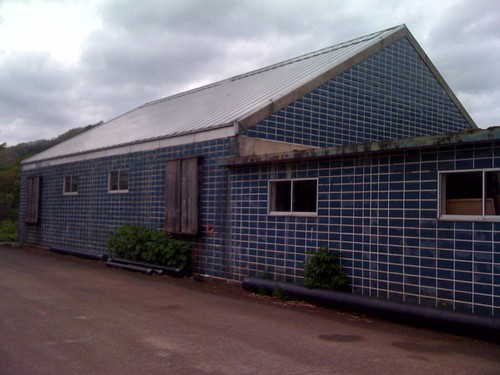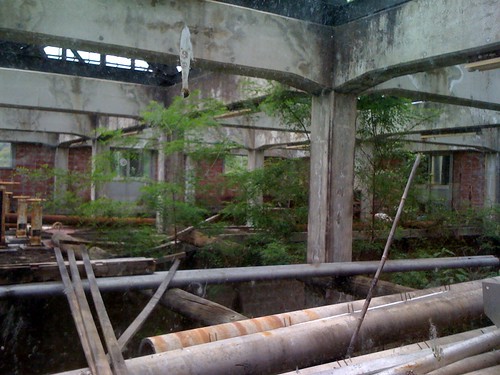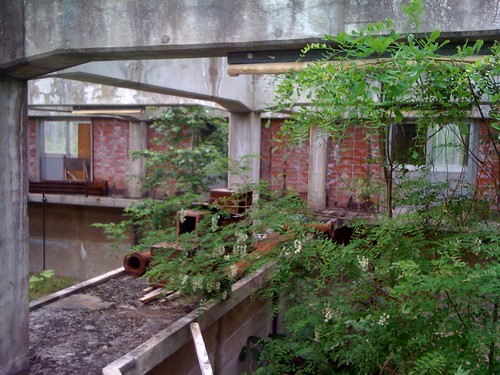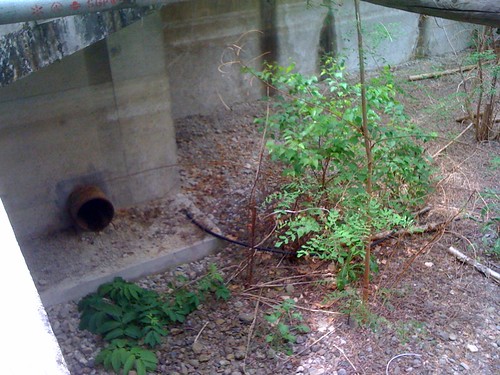
Today, on one of the booken (adventures) that my supervisor often takes me on, I was lead through a locked door to the interior of an abandoned-looking building. I’d been by on my bike to investigate the building and the construction going on beside it last year. However, what windows there were began at least five feet off the ground, and even those were boarded over. As I craned my neck to see in, all that I could glimpse between intervening boards were hints of greenery inside this obviously derelict, yet remarkably intact, structure.
Heading inside today, we first entered a large, garage-like room that was being used for town storage (as most of the disused municipal buildings seem to be), but beyond the piles of signs and snowmobiles and miscellaneous ceremonial bits, there were metal stairs up to a half-sized sliding glass door. As my supervisor and the facility’s technician poked around in the storage, myself and Obara-san went on through the small sliding door and out onto a concrete catwalk.
The temperature beyond the door jumped a good ten degrees beneath the unbroken, peaked glass roof. All along the catwalk were remains of valves and piping, and below were two large concrete pits. Though they were dry, pipes running through their walls betrayed the fact that they had once been pools…as did the trees growing among their broken concrete. It had been these slim saplings, taking advantage of this water-treatment-facility-cum-greenhouse, that I’d glimpsed between the boards over the windows—these trees that had so confused me about what this place was.
The once-purposeful-yet-now-gone-to-seed feel of it reminded me of nothing so much as a Dharma installation out of Lost. The setting of the facility, half-way up the side of a verdant mountain, with similarly lush hills ringing it and blocking out any hint of the town beyond, certainly helped to give the impression that somewhere along the way we’d left Hokkaido and wound up on The Island.
And if the de-facto greenhouse gave the impression of Dharma That Was, walking across the courtyard, past a coy pond and through the barbed-wire-lined gates into the operational building next door was like stepping back to Dharma’s Golden Age. We were given a tour of the facility’s cool, wet interior, and the site’s technician spoke to me in Japanese about processes that I wouldn’t have understood in English. While describing the methods and apparatuses used to distill raw water into something fit for us to drink, the parts of his vocabulary I picked up on were like incantations or haikus for the hydromagic that they wrought in that building.
There was “snow” and “mountain” and “electricity;” “garbage” and “water,” and “up” and “down.” To describe the clean water, he used kirei, the word that also means “beautiful,” and the notion that the end goal of this collection of pools and pipes and pumps was “beautiful water” only added to the alchemy of it. He took us across the more modern, concrete facsimiles of the catwalks we’d been out on in The Greenhouse, and he peeled back flexible layers of plastic sheeting to reveal ponds far deeper than those we’d encountered next door. He pointed down into the dark water, indicating the arcane machinery stirring menacingly in the depths.
Standing on the lips of those wells, with only a scant rigging of aluminum lattice and plastic siding standing between the observer and meters of water, I was gripped by a unique vertigo that was as much being afraid of the dark as it was a fear of falling.
And, of course, in a turn of events fitting of the sustained mystery that is Dharma, the only camera I had to hand upon making this wondrous discovery was my poor iPhone one.










No comments:
Post a Comment